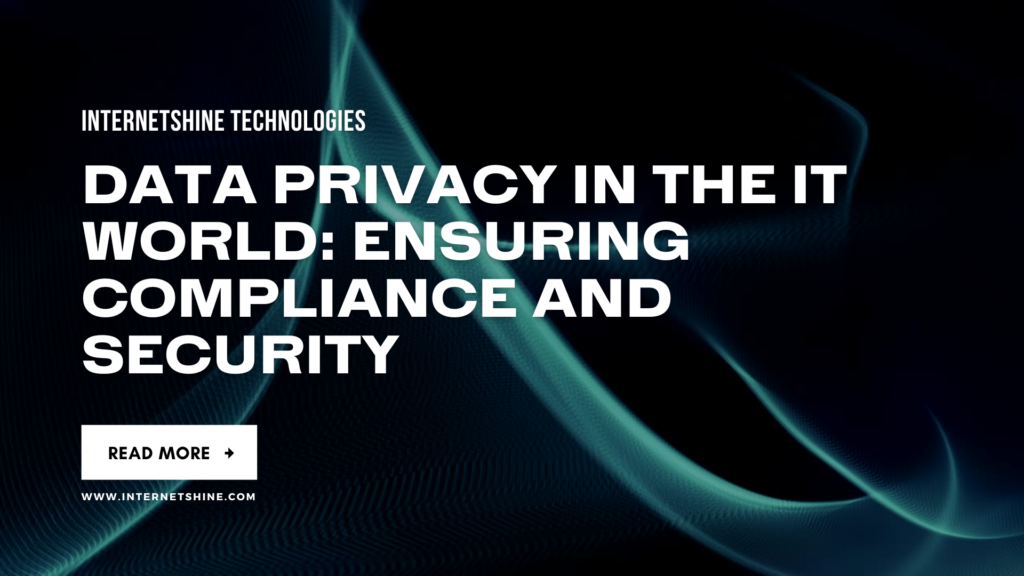In today’s digitally-driven world, data privacy has emerged as a critical concern for organizations and individuals alike. With the exponential growth of data collection and the increasing sophistication of cyber threats, ensuring compliance and security in IT has never been more important. This blog explores the key aspects of data privacy in the IT world, the challenges organizations face, and the best practices for ensuring compliance and security.
Understanding Data Privacy in IT
Data privacy refers to the protection of personal and sensitive information from unauthorized access, use, or disclosure. In the IT world, this involves safeguarding data collected, stored, and processed by organizations, ensuring that it is only accessible to authorized personnel and used in compliance with relevant regulations.
The Importance of Data Privacy Compliance
Compliance with data privacy regulations is not just a legal requirement; it is also essential for maintaining customer trust and avoiding costly penalties. Key regulations like the General Data Protection Regulation (GDPR) in Europe, the California Consumer Privacy Act (CCPA) in the United States, and the Personal Data Protection Bill in India mandate organizations to implement stringent measures to protect personal data.
Non-compliance can result in severe penalties, including hefty fines and reputational damage. For instance, under the GDPR, organizations can be fined up to 4% of their annual global turnover or €20 million, whichever is greater, for serious breaches. This underscores the importance of adhering to data privacy regulations and implementing robust security measures.
Challenges in Ensuring Data Privacy
- Complex Regulatory Landscape: Navigating the complex and evolving regulatory landscape can be challenging for organizations, especially those operating in multiple jurisdictions. Each region may have its own set of data privacy laws, making compliance a daunting task.
- Increasing Cyber Threats: The rise of sophisticated cyber threats, including phishing, ransomware, and data breaches, poses significant risks to data privacy. Cybercriminals are constantly evolving their tactics, making it crucial for organizations to stay ahead of the curve in terms of security.
- Data Overload: The sheer volume of data generated and processed by organizations can make it difficult to manage and protect sensitive information effectively. Ensuring that data is appropriately categorized, stored, and secured is a major challenge.
- Employee Awareness: Human error is a leading cause of data breaches. Employees who are not adequately trained in data privacy best practices can inadvertently compromise sensitive information, making awareness and training essential components of any data privacy strategy.
Best Practices for Ensuring Data Privacy Compliance and Security
- Conduct Regular Audits: Regular audits of data privacy practices can help identify potential vulnerabilities and ensure compliance with relevant regulations. Audits should include assessments of data storage, access controls, and incident response procedures.
- Implement Strong Access Controls: Limiting access to sensitive data to only those who need it is a key component of data privacy. Implementing multi-factor authentication (MFA), role-based access controls, and encryption can help protect data from unauthorized access.
- Stay Updated on Regulations: Keeping up with changes in data privacy regulations is crucial for ensuring compliance. Organizations should designate a data protection officer (DPO) or a similar role to monitor regulatory developments and ensure that the organization’s practices remain compliant.
- Invest in Security Technologies: Leveraging advanced security technologies, such as encryption, intrusion detection systems, and firewalls, can help protect data from cyber threats. Additionally, regular updates and patches to software and systems are essential to address vulnerabilities.
- Train Employees on Data Privacy: Comprehensive training programs should be implemented to educate employees about data privacy best practices, including how to recognize phishing attempts, handle sensitive information, and report potential breaches.
- Develop a Data Breach Response Plan: Having a well-defined response plan in place can help organizations quickly and effectively address data breaches, minimizing the impact on customers and the organization. The plan should include procedures for containing the breach, notifying affected individuals, and reporting the incident to relevant authorities.
Conclusion
Data privacy in the IT world is a complex and ever-evolving challenge that requires organizations to be proactive in ensuring compliance and security. By understanding the importance of data privacy, recognizing the challenges, and implementing best practices, organizations can protect sensitive information, maintain customer trust, and avoid costly penalties. As data privacy regulations continue to evolve, staying informed and vigilant will be key to navigating the digital landscape securely.
